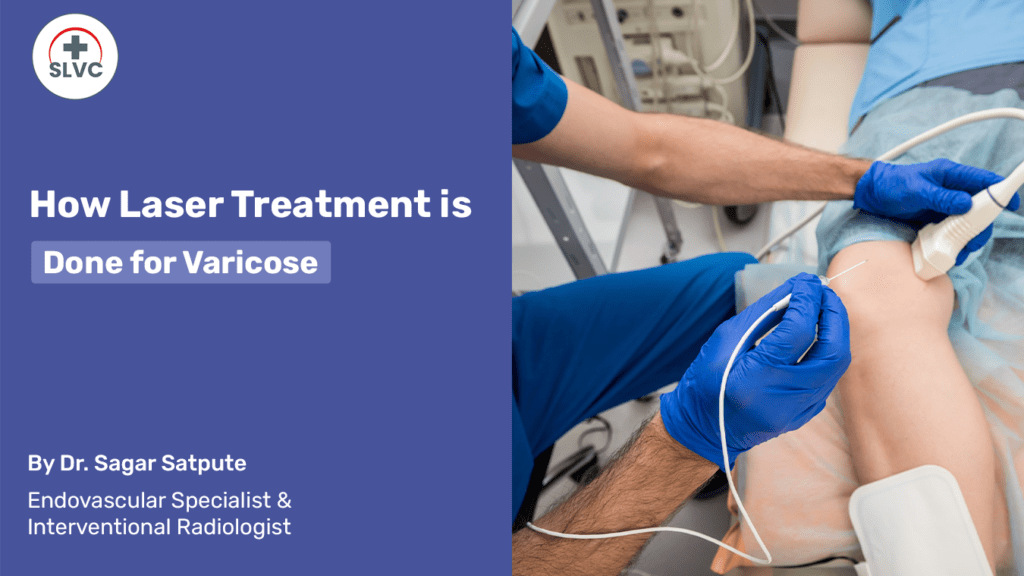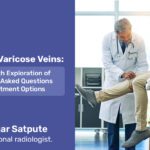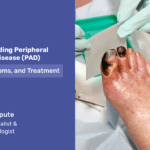Mobile
+91 8369559053
drsagputelimbandvesselcare@gmail.com
How Laser Treatment is Done for Varicose Veins?

Table of Contents
Overview
Varicose veins, those enlarged and twisted veins often seen in the legs, have been a longstanding concern for many individuals. Beyond their cosmetic impact, these veins can lead to discomfort, pain, and even more severe complications if left untreated. Fortunately, advancements in medical technology have paved the way for more effective and less invasive treatment options, such as laser treatment, which offers patients a road to recovery with reduced downtime and enhanced results. In this comprehensive article, we will delve into the intricate world of varicose vein treatment through laser therapy, exploring its process, benefits, and what patients can expect throughout the journey.
Varicose Veins Treatment
Before diving into the specifics of laser treatment, it’s essential to understand the broader landscape of varicose veins treatment. Varicose veins have historically been managed through surgical procedures like vein stripping and ligation. While effective, these methods involved incisions, often leading to longer recovery times, potential scarring, and discomfort for patients.
Advanced Treatment for Varicose Veins
The evolution of medical science has ushered in a new era of varicose vein treatment, characterized by advanced and minimally invasive options. Laser treatment, in particular, has emerged as a groundbreaking approach due to its effectiveness and patient-friendly attributes.
Color Doppler Test for Varicose Veins
Before any treatment plan is initiated, a thorough evaluation of the veins is essential. The Color Doppler test, a non-invasive imaging technique, takes center stage in this assessment. By providing a real-time visualization of blood flow within the veins, this test aids in diagnosing underlying issues that contribute to varicose veins, guiding the choice of treatment.
Perforator Veins in Legs
Perforator veins, which bridge the gap between superficial and deep veins in the legs, can play a crucial role in the development of varicose veins. Addressing these veins is pivotal, as they often contribute to blood reflux, exacerbating the condition. Identifying and treating perforator veins is a critical step in ensuring a successful treatment outcome.
Tests/Steps Before Varicose Veins Surgery
Embarking on a treatment journey requires meticulous planning and consideration. Before undergoing any varicose vein procedure, patients undergo a series of tests and steps. These include a comprehensive review of medical history, a physical examination, and diagnostic tests like ultrasound and venous duplex scans. These tests provide a comprehensive picture of the vein anatomy, helping healthcare providers tailor the treatment approach to the patient’s unique needs.
Steps of Laser Treatment for Varicose Veins
At the heart of this article lies the laser treatment procedure itself. Endovenous Laser Ablation (EVLA), a minimally invasive technique, involves the insertion of a laser fiber into the affected vein. Under the guidance of real-time ultrasound imaging, the fiber delivers controlled laser energy to the vein’s inner lining. This causes the vein to close off, redirecting blood flow to healthier veins and gradually fading the appearance of the varicose vein.
Sclerotherapy for Varicose Veins
While laser treatment is a potent solution, sclerotherapy also plays a role in addressing varicose veins. Particularly effective for smaller veins or as a complementary treatment, sclerotherapy involves injecting a special solution into the vein. This solution irritates the vein lining, causing it to collapse and eventually fade away.
Post-Surgery Results
The aftermath of varicose vein treatment can yield remarkable results. Patients often report reduced pain, decreased swelling, and a notable improvement in aesthetics. By effectively addressing varicose veins, potential complications such as ulcers and blood clots can be prevented, offering patients a renewed sense of well-being and confidence.
Compression Bandage for Varicose Veins
In the recovery phase, compression bandages or stockings play a pivotal role. These garments apply external pressure on the treated veins, aiding in the healing process, reducing swelling, and preventing blood from pooling. This essential step enhances the overall effectiveness of the treatment.
Post Varicose Veins Surgery
As patients progress in their recovery, adhering to post-operative guidelines is crucial. Engaging in light activities, avoiding prolonged periods of sitting or standing, and following any prescribed medications contribute to a smooth recovery process.
Conclusion
In conclusion, the path to treating varicose veins through laser therapy is paved with innovative medical techniques and patient-focused care. With a comprehensive understanding of the steps involved in this procedure, individuals can make informed decisions about their treatment journey. Laser treatment not only addresses the cosmetic aspects of varicose veins but also empowers patients to take control of their vascular health. Through expert guidance and cutting-edge technology, patients can embark on a journey to healthier, pain-free legs, bidding farewell to the discomfort and limitations posed by varicose veins.
Latest Blogs
-
Understanding DVT: How Blood Clots Can Lead to Serious Consequences
February 24, 2024





